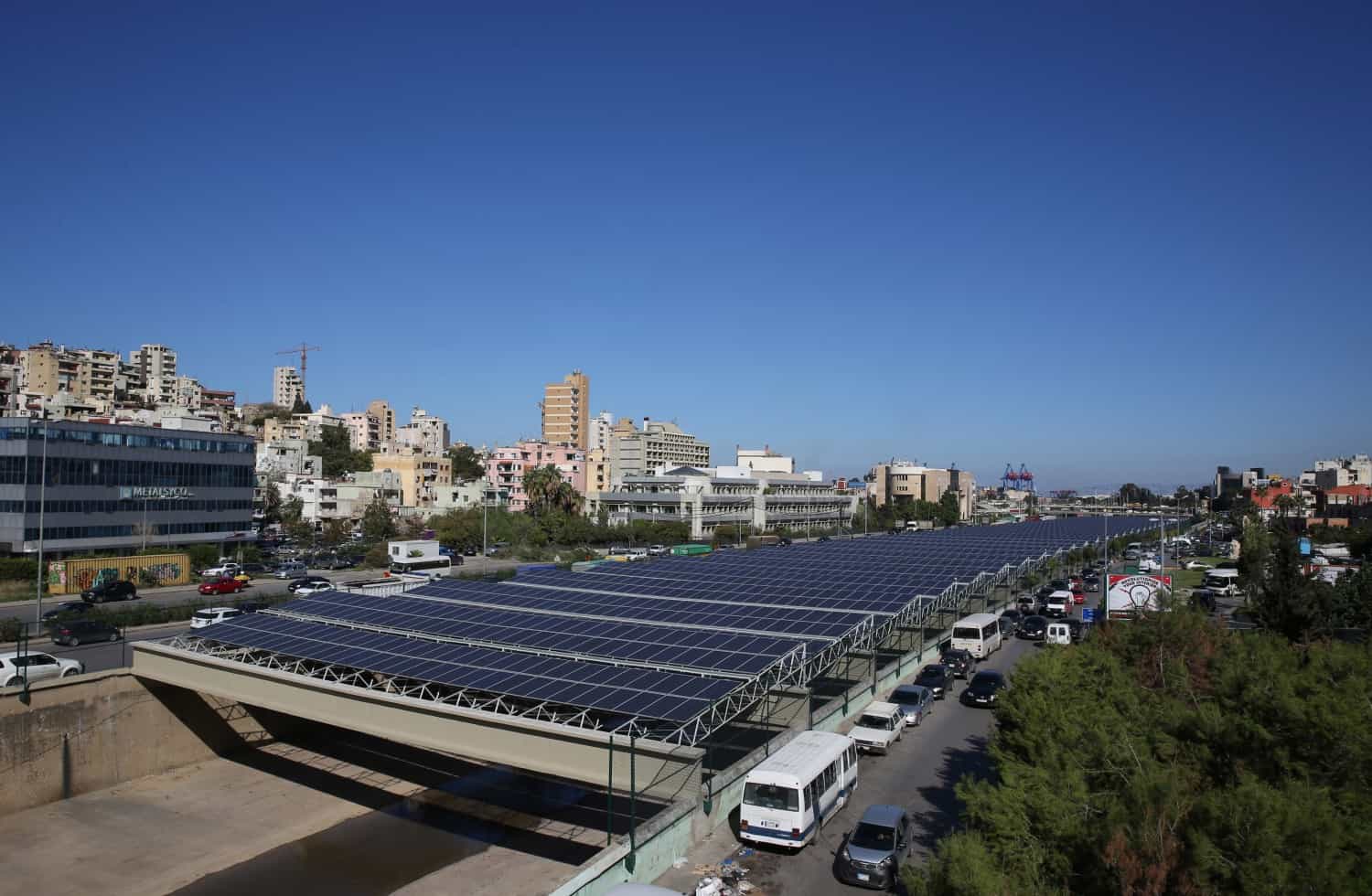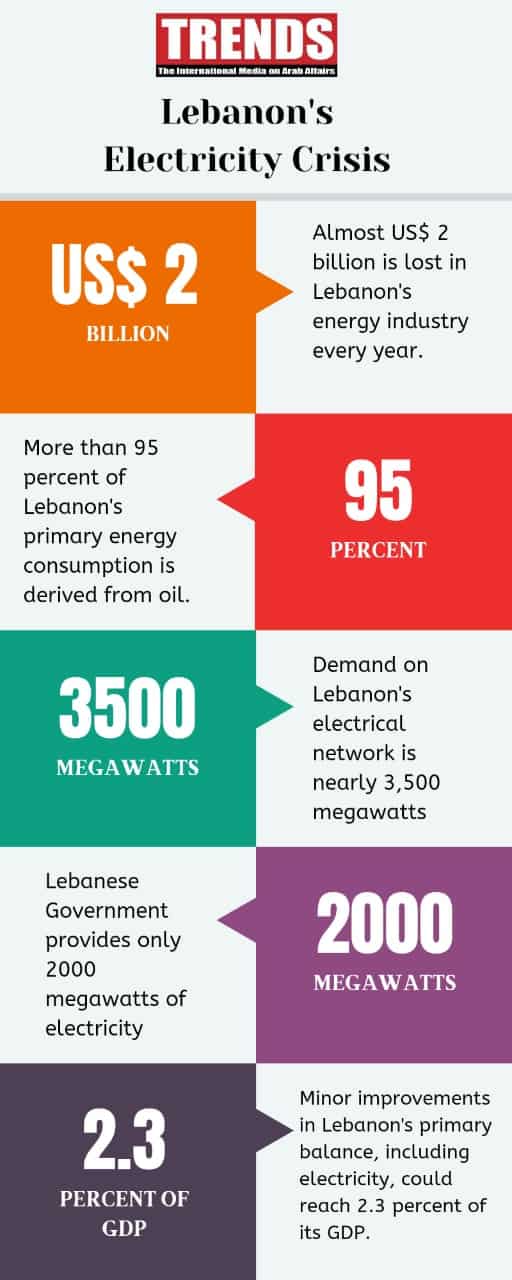The electricity crisis is not new in Lebanon. Everyone living in this 10,452 square kilometers nation knows that the government’s feeding doesn’t exceed 12 hours per day at best outside “the administrative” Beirut. While private generators cover the remaining hours, knowing that the residents of the villages may not be able to pay for private generators.
But with the beginning of the economic crisis in 2019, inflation rates have risen, the Lebanese pounds (L.L.) collapsed against the U.S. dollar, the electrical supply has worsened, at a time when hospitals and public facilities are living amid fears of a continuous shortage of fuel.
Electricity Cost and Losses
Economist Jassem Ajaka acknowledged that the cost of producing power in Lebanon is lower than the price paid by citizens, which has amassed significant debts and raised the financial crisis in recent years. However, the problem with Lebanon’s power sector is the lack of reformation and investments in the last two decades, and the trouble resides primarily in production, theft, and network violations.
Between US$ 1.5 billion and 2 billion is lost in Lebanon’s energy industry every year, and this sector has cost the state treasury over US$ 50 billion in advances to the Electricité du Liban (the Government’s electricity institution), or it may be contributions that will not be repaid.
More than 95 percent of Lebanon’s primary energy consumption is derived from oil. As a result, the vast bulk of the country’s energy needs is met by importing it. Therefore, Electricité du Liban relies on central bank dollars to finance fuel purchases. In addition, the economic crisis in 2019 contributed to the scarcity of energy and the lack of electrical power.
Because political conflicts have stymied earlier proposals offered by the Ministry of Energy, Ajaka suggested alternatives like liberalizing the power sector by allowing private companies to take over production management.
Citizens’ experience
As mentioned earlier, a Lebanese resident pays two electricity bills: one for the government and another for the private generators. During the past two years, private generators prices have risen intensively from around 150,000 L.L/ month to 1,500,000 L.L/ month for 5 amp. Let’s discover how electricity is supplied in different Lebanese regions!
Rami from Bchamoun (Area near Beirut in the Mount Lebanon)
Before the economic crisis, the governmental electricity supply was 6 hours compared to 6 hours cut off, but now the feeding does not exceed one hour per day. According to the black market, Rami pays about 1,700,000 L.L. for 5 amp monthly to the private generator for 11 hours of electricity daily, which is currently equivalent to US$ 70 and equal to an average employee’s salary in the public sector.
Muhammad from Akkar (District at the far North of Lebanon)
The electricity supply reached about 12 hours per day as a general average in Akkar before the economic crisis, but it has worsened over the past two years, getting one hour per day. As for the private generators currently provide only 8 hours of feeding for about 1,000,000 L.L per month for 5amp.
Jamal from Baalbek (City at the foot of the south-west slope of Anti-Lebanon)
Before the economic crisis, the electricity supply was 6 hours compared to 6 hours cut off, but it does not currently reach about an hour a day. In comparison, private generators provide 7 hours of feeding per day only for 1,500,000 LL.
Sami from Kfour (Village at the South of Lebanon)
The electricity supply reached between 10 and 12 hours per day as a general average before the economic crisis, but currently, it does not exceed two hours per day. On the other hand, private generators provide about 10 hours of electricity daily, for 2,000,000 L.L/ month, for 5 amp; knowing that private generators compensated the Government’s nutrition electricity two years ago.
Some villages in the Bekaa, north, and south of Lebanon face harsher conditions in terms of electricity supply or private generators than the administrative Beirut, where government feeding reaches about 6 hours a day. Despite the economic crisis, private generators cover the gaps in exchange for up to 3,000,000 L.L per month for five amps.
Electricity Deficit in details
Electricity shortages in Lebanon are caused mainly by an imbalance between supply and demand, with neither diesel-powered nor hydroelectric facilities generating enough power to meet the country’s growing demand.
Ahmed Daher, an energy specialist, stated that the demand for Lebanon’s electrical network is 3,500 megawatts, while only 2,000 megawatts are produced, resulting in a power shortfall. In addition, there has been an increasing deficit since last year’s economic crisis, exacerbated by an exchange rate collapse due to a levy that is still on the old price, which is 135 L.L per KWH. In comparison, the manufacturing cost exceeds 18 cents per KWH (3500 L.L).
Electricite Du Liban can’t just change its pricing and start charging its customers at the actual cost (18 cents per KWH); even though this is cheaper than utilizing private generators, citizens won’t go along with it, according to Daher, making it a serious social issue.
Solutions
There are several possible solutions, but none of them avoid the necessity of building new production facilities (regardless of the technology used) and expanding already existing facilities to make up for the shortfall.
As outlined in the Ministry of Energy’s 2010-2020 plans, Lebanon seeks to boost its reliance on renewable energy, especially in light of Lebanon’s commitment at the Paris Climate Conference to increase the usage of renewable energy to 30 percent of its total consumption by 2030. However, the shortfall in electricity can’t be filled solely by renewable energy sources.
Traditional plant development and connecting lines with friendly countries are also part of the solution. Solar energy is a part of the solution, as is the development of traditional plants.
We should not forget that in terms of technical and non-technical losses, we have feed grid losses of up to 50 percent.
Lebanon’s Agreements and Promises
Cedre Conference Statement 2018
The Lebanese Government apprehends the importance of structural and sectoral changes to attract new investment and develop modern and crucial infrastructure. Therefore, the Government intends to resolve structural problems and loopholes while promoting long-term public and private investment. On structural reform, the Lebanese Government stressed the significance of anti-corruption measures like strengthening governance and accountability, modernizing procurement procedures, and reforming customs.
The statement added that the Lebanese authorities are also committed to enhancing their anti-money laundering measures and countering terrorism financing in accordance with international standards of conduct. Furthermore, for the Carriage and Insurance Paid To (CIP) to be successful, three areas of reform are considered essential: electricity; water management, a new strategy based on decentralization is currently being implemented.
International Monetary Fund
2019 Consultation Statement released by IMF staff mentioned the most important notes to strengthen Lebanon’s economy by focusing on three areas: improving governance, implementing the electricity sector reform plan, and the recommendations of “Lebanon’s Economy Vision.”
The committee in 2019 anticipated that the primary deficit in Lebanon might be reduced in 2020-2022 due to the budgetary measures and the savings from the energy sector changes, but the debt would continue to rise. The impact of minor improvements in the primary balance, including electricity, could reach 2.3 percent of Lebanon’s GDP.
Startups Initiatives: Solar System as a solution
Startups have shown significant interest in the electricity crisis in Lebanon, and the youth presented several solutions which can be done in some regions of Lebanon, if not all the country.
Rayan Al Sarih, CEO at G4WT startup, mentioned in an interview with TRENDS, talked about her project, which is wind turbine generators that can be installed in small-scale areas like small buildings, farms, and other places in the villages outside Beirut mainly.
G4WT generators run with minimal wind speed and noise, using the latest technologies like machine learning. However, it is also unique in its cost compared to Lebanon’s existing crisis management methods.
For example, people in Lebanon spend 40-50 cents per KWH, while G4WT installation is between 15 to 20 cents per KWH. The turbine has a lifetime of between 20 and 25 years.
Another initiative was made by Wael Zmerly, CEO at Azca Solar, who clarified that water heating is the biggest problem with electricity cuts since some people in Lebanon don’t have warm water to shower,
Azca Solar is a solar water heater made in Lebanon for the middle class and below. Its installment prices are between US$ 500-600 only and is a massive benefit for the Government in the future since it lowers the need for electricity.
Solar Energy Systems need a governmental plan
After the high governmental electricity shortfall and the rationing of private generators, many individuals turned to alternatives, such as purchasing an off-grid system for their homes and reducing their dependence on Electricité du Liban and private generators.
Despite that, it’s always a good thing when individuals switch to renewable energy and solutions that are less harmful to the environment and less reliant on fossil fuels. However, this issue is regarded as a problem when installing solar energy systems without coordination with Electricité du Liban, according to Energy Expert Ahmed Daher,
Because of the short payback period (less than four years) for large-scale installations like factories, enterprises, and hotels, Lebanon’s solar energy installation market is likely to shift from the currently booming residential sector.
To keep the public security, Daher advised individuals on choosing solar energy for their homes:
1- Choose a well-known company with a reputable background.
2- Use well-known merchandise.
3- Ensure that the engineers or technicians are competent


